Autonomous vehicles promise enhanced safety, reduced traffic congestion, and increased mobility for those unable to drive. This article explores key technologies enabling these vehicles, their societal benefits, unique models, challenges to adoption, urban planning implications, and ethical considerations. Understanding these aspects is crucial as we navigate the future of transportation.
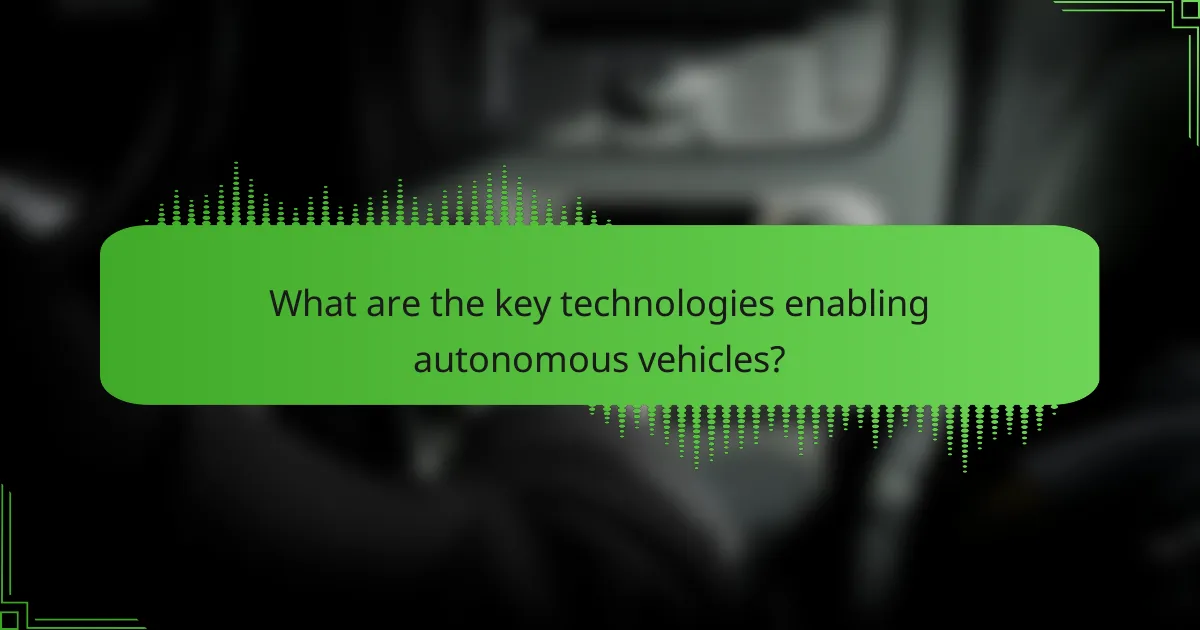
What are the key technologies enabling autonomous vehicles?
Key technologies enabling autonomous vehicles include artificial intelligence, machine learning, computer vision, LiDAR, radar, and advanced sensor systems. These technologies work together to enhance vehicle perception, decision-making, and navigation.
Artificial intelligence processes vast amounts of data for real-time decision-making. Machine learning algorithms improve vehicle performance by learning from past experiences. Computer vision enables vehicles to interpret visual information from their surroundings. LiDAR provides detailed 3D maps of the environment, while radar detects objects in various weather conditions. Advanced sensor systems integrate data from multiple sources to ensure safety and efficiency.
The combination of these technologies is crucial for developing fully autonomous vehicles, enhancing safety, reducing human error, and paving the way for future transportation solutions.
How does sensor technology enhance vehicle perception?
Sensor technology significantly enhances vehicle perception by providing real-time data for navigation and obstacle detection. This technology uses various sensors, including radar, lidar, and cameras, to create a comprehensive understanding of the vehicle’s environment. For instance, lidar systems can generate precise 3D maps of surroundings, enabling better decision-making. As a result, autonomous vehicles can improve safety and efficiency through advanced perception capabilities. The integration of these sensors allows vehicles to detect pedestrians, other vehicles, and road conditions, ultimately leading to a more reliable driving experience.
What role does artificial intelligence play in navigation?
Artificial intelligence is crucial for navigation in autonomous vehicles, enhancing safety and efficiency. AI processes real-time data from sensors, enabling vehicles to understand their surroundings and make informed decisions. This technology includes pathfinding algorithms that optimize routes and machine learning models that improve over time. AI’s ability to analyze vast amounts of data leads to better traffic management, reduced congestion, and improved travel times. Furthermore, AI integration allows vehicles to adapt to changing conditions, ensuring a safer driving experience.
Which communication systems are vital for vehicle-to-everything (V2X) interactions?
Critical communication systems for vehicle-to-everything (V2X) interactions include Dedicated Short-Range Communications (DSRC), Cellular Vehicle-to-Everything (C-V2X), and Wi-Fi. These systems enable real-time data exchange between vehicles, infrastructure, and other road users. DSRC provides low-latency communication ideal for safety applications. C-V2X leverages existing cellular networks, supporting broader coverage and scalability. Wi-Fi enhances connectivity in urban environments, facilitating data sharing and traffic management. Each system plays a unique role in enhancing the safety and efficiency of autonomous vehicles.
How do software updates improve functionality over time?
Software updates enhance the functionality of autonomous vehicles by improving algorithms, refining sensors, and integrating new features. Regular updates optimize performance, increase safety, and adapt to evolving traffic regulations and environments. Enhanced machine learning models improve decision-making capabilities over time, ensuring vehicles respond better to real-world scenarios. Additionally, updates can address security vulnerabilities, protecting user data and vehicle integrity.
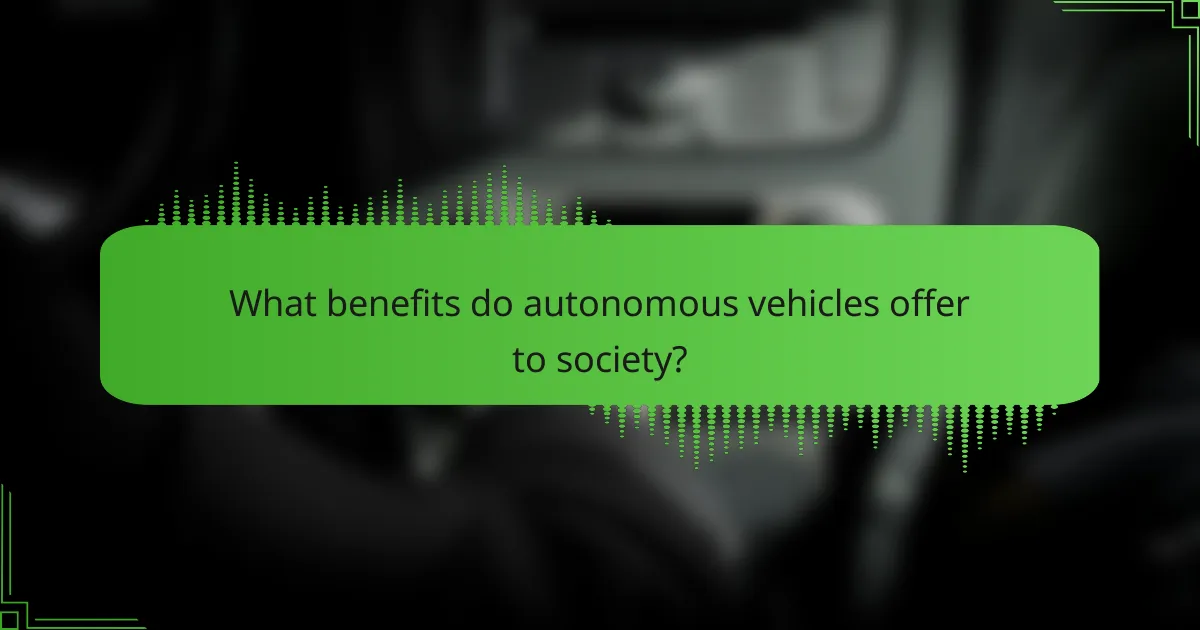
What benefits do autonomous vehicles offer to society?
Autonomous vehicles offer significant benefits to society, including enhanced safety, reduced traffic congestion, and increased mobility for individuals unable to drive. These vehicles can minimize human error, which accounts for approximately 94% of traffic accidents. As a result, they have the potential to save thousands of lives annually. Furthermore, autonomous vehicles can optimize traffic flow through advanced algorithms, decreasing travel times and emissions. They also provide greater access to transportation for elderly and disabled populations, fostering inclusivity and independence.
How can they reduce traffic accidents and fatalities?
Autonomous vehicles can significantly reduce traffic accidents and fatalities through advanced safety features and real-time data processing. These vehicles utilize sensors and artificial intelligence to identify hazards, enabling quicker response times than human drivers. Studies indicate that autonomous technology could decrease crash rates by up to 90%. This reduction stems from eliminating human errors, such as distracted or impaired driving. Furthermore, vehicles communicate with each other and infrastructure, enhancing traffic flow and minimizing collisions. As the technology evolves, its potential to save lives increases, making roads safer for everyone.
What impact do they have on traffic congestion?
Autonomous vehicles can significantly reduce traffic congestion by optimizing driving patterns and improving traffic flow. These vehicles utilize advanced algorithms and real-time data to minimize stop-and-go traffic, leading to smoother commutes. Studies suggest that widespread adoption could decrease congestion by up to 30%. Additionally, autonomous vehicles can communicate with each other, reducing the need for excessive lane changes and enhancing road capacity. This technology not only improves efficiency but also enhances safety, further contributing to reduced congestion levels.
How do autonomous vehicles contribute to environmental sustainability?
Autonomous vehicles significantly enhance environmental sustainability by reducing emissions and improving energy efficiency. They optimize driving patterns, leading to less fuel consumption and lower greenhouse gas emissions.
Additionally, autonomous vehicles can facilitate the use of electric powertrains, further decreasing reliance on fossil fuels. A study found that fully autonomous electric vehicles could reduce carbon emissions by up to 80% compared to traditional vehicles.
Their ability to coordinate with smart traffic systems minimizes congestion, which also contributes to energy savings. As a result, autonomous vehicles represent a pivotal shift towards greener transportation solutions.
What economic advantages do they present for businesses?
Autonomous vehicles present significant economic advantages for businesses, including reduced operational costs and increased efficiency. They lower labor expenses by minimizing the need for drivers and enhance logistics through optimized routing. Additionally, these vehicles can operate around the clock, increasing productivity. The long-term savings on fuel and maintenance further contribute to overall profitability.
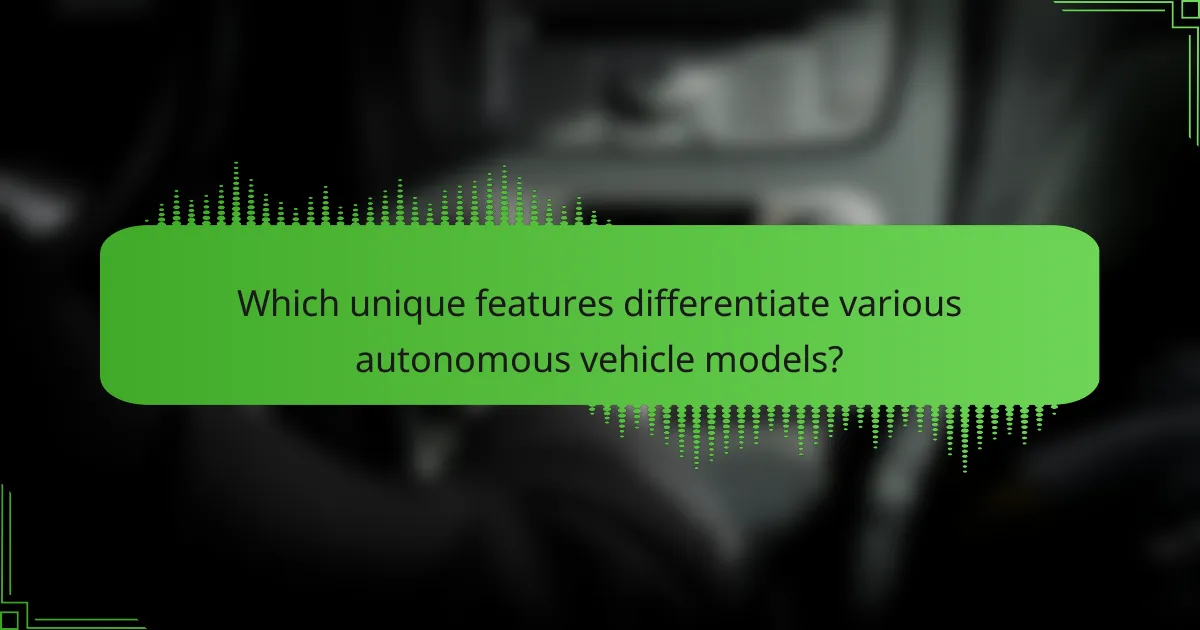
Which unique features differentiate various autonomous vehicle models?
Various autonomous vehicle models differ through unique features such as sensor technology, software algorithms, and design specifications.
| Model | Unique Feature | Value |
|—————————|—————————————-|————————|
| Tesla Model S | Full Self-Driving capability | Level 5 autonomy |
| Waymo One | Advanced LIDAR system | 360-degree perception |
| Cruise Origin | Purpose-built design | No steering wheel |
| Aurora Driver | Multi-modal sensor fusion | Enhanced environment understanding |
| Zoox Vehicle | Bidirectional driving capability | Optimized for urban environments |
| Nuro R2 | Delivery-focused design | Smaller footprint |
How does Tesla’s Autopilot compare to Waymo’s self-driving technology?
Tesla’s Autopilot offers advanced driver-assistance features, while Waymo’s self-driving technology is fully autonomous. Tesla focuses on user engagement and gradual automation, whereas Waymo emphasizes complete autonomy without human intervention.
| Feature | Tesla Autopilot | Waymo Self-Driving |
|————————-|———————–|———————–|
| Level of Autonomy | Level 2 | Level 4 |
| Human Intervention | Required | Not required |
| Geographic Limitations | Limited to certain areas| Urban environments |
| Sensor Technology | Cameras and radar | Lidar and cameras |
| Safety Record | Improving | Extensive testing |
| Availability | Consumer vehicles | Ride-hailing service |
What are the distinct safety features in different brands?
Different brands of autonomous vehicles incorporate unique safety features tailored to enhance passenger protection. Key distinctions include advanced sensor systems, emergency braking capabilities, and real-time monitoring.
| Brand | Safety Feature | Description |
|——————-|——————————|———————————————-|
| Tesla | Autopilot | Uses cameras and radar for real-time navigation. |
| Waymo | Lidar Technology | Employs laser sensors for precise environment mapping. |
| Ford | Co-Pilot360 | Integrates multiple cameras for 360-degree awareness. |
| GM Cruise | Safety Driver | Features a remote operator for emergency intervention. |
| Audi | Traffic Jam Pilot | Automates driving in congested conditions for safety. |
| Nissan | ProPILOT Assist | Offers lane-keeping and adaptive cruise control. |
How do luxury models enhance user experience differently?
Luxury models enhance user experience through advanced technology, superior materials, and personalized features. These vehicles often integrate cutting-edge autonomous capabilities, providing seamless navigation and safety. High-quality interiors and customizable options elevate comfort and aesthetics, catering to individual preferences. Additionally, luxury brands prioritize user interface design, ensuring intuitive controls and connectivity, which enrich the overall driving experience.
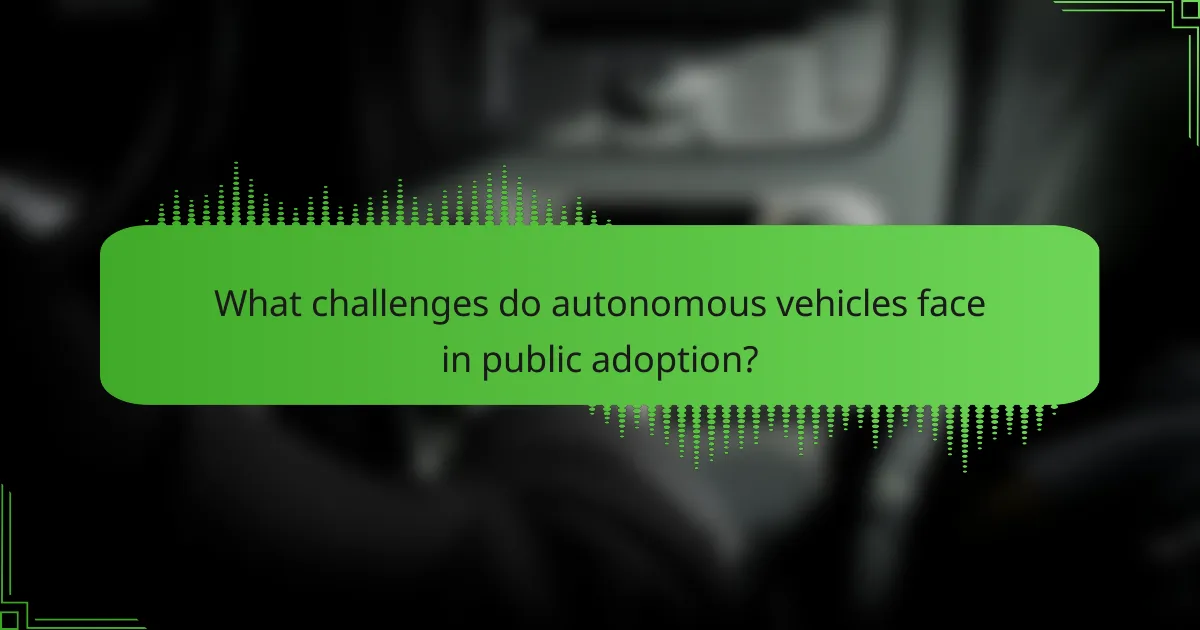
What challenges do autonomous vehicles face in public adoption?
Autonomous vehicles face significant challenges in public adoption, including safety concerns, regulatory hurdles, and public perception. Safety remains a primary issue, as incidents involving autonomous vehicles can lead to distrust. Regulatory frameworks are still developing, creating uncertainty for manufacturers and consumers. Public perception often lags behind technology, with many people hesitant to embrace the shift. Additionally, infrastructure readiness and cybersecurity threats pose further barriers to widespread acceptance. Addressing these challenges is crucial for the successful integration of autonomous vehicles into society.
How do regulatory frameworks impact development and deployment?
Regulatory frameworks significantly influence the development and deployment of autonomous vehicles by establishing safety standards and operational guidelines. Compliance with these regulations shapes technology advancements and market entry strategies. For instance, stringent safety requirements may delay deployment timelines but enhance public trust. Additionally, regulatory variations across regions can lead to inconsistent development paths, impacting global competitiveness. As a result, harmonizing regulations can foster innovation while ensuring safety and efficiency in autonomous vehicle integration.
What public perception issues hinder acceptance?
Public perception issues significantly hinder the acceptance of autonomous vehicles. Concerns about safety, reliability, and ethical implications dominate consumer attitudes. Many people fear technology failures or accidents involving these vehicles. Additionally, trust in the decision-making processes of autonomous systems remains low. Public understanding of the benefits and capabilities of autonomous vehicles is often limited, leading to skepticism. Misconceptions about the technology further exacerbate resistance to adoption.
Which technological limitations still need addressing?
Technological limitations in autonomous vehicles include sensor reliability, data processing speed, and decision-making algorithms. These areas require further development to ensure safety and efficiency in diverse driving conditions.
Key challenges are:
1. Sensor limitations in adverse weather conditions.
2. Real-time data processing to manage complex environments.
3. Advanced decision-making capabilities to predict human behavior.
4. Cybersecurity measures to protect against hacking.
5. Infrastructure compatibility for seamless integration.
6. Regulatory frameworks that adapt to rapid technological advancements.
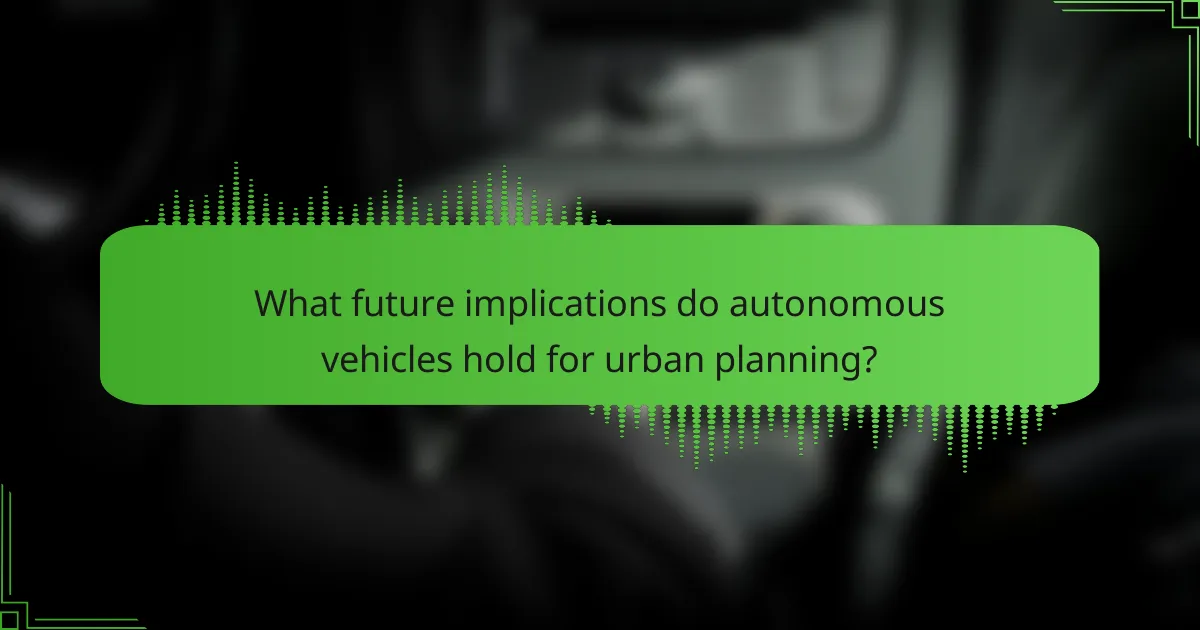
What future implications do autonomous vehicles hold for urban planning?
Autonomous vehicles will significantly reshape urban planning by reducing the need for parking spaces and changing traffic flow patterns. As these vehicles become prevalent, cities can repurpose land currently used for parking into green spaces or residential areas.
Additionally, autonomous vehicles can improve accessibility for underserved communities. They can facilitate public transportation options, making it easier for individuals without access to personal vehicles to navigate urban environments.
Moreover, the integration of smart transportation systems will enhance traffic management. Real-time data from autonomous vehicles can optimize traffic signals and reduce congestion, leading to more efficient urban mobility.
Finally, cities will need to adapt infrastructure to support electric autonomous vehicles, including charging stations and maintenance facilities. This shift will promote sustainable urban development and contribute to lower emissions.
How will they influence infrastructure design and investment?
Autonomous vehicles will significantly influence infrastructure design and investment by necessitating smarter road systems. They require advanced technologies, such as vehicle-to-infrastructure communication, which will drive investments in digital networks.
Furthermore, the integration of autonomous vehicles will lead to a reevaluation of urban planning. Cities will need to accommodate new traffic patterns and reduce parking spaces, as these vehicles can drop passengers off and park themselves remotely.
The shift towards shared autonomous fleets will also promote the development of multi-modal transportation hubs. These hubs will facilitate seamless transitions between different transport modes, optimizing urban mobility.
As a result, infrastructure investments will increasingly focus on sustainability and efficiency, aligning with the broader goals of smart city initiatives. This transformation will redefine how cities allocate resources and prioritize projects.
What changes might occur in public transport systems?
Public transport systems may undergo significant changes due to the integration of autonomous vehicles. These vehicles can enhance efficiency, reduce congestion, and improve safety in urban areas.
Autonomous vehicles can operate on demand, allowing for flexible routing and scheduling. This adaptability can lead to better service coverage, especially in underserved regions. As a result, public transport may become more accessible and user-friendly.
The shift towards autonomous vehicles could also reduce operational costs for transport agencies. With fewer drivers needed, resources can be redirected towards improving infrastructure and technology.
Lastly, the environmental impact may be positive, as many autonomous vehicles are designed to be electric, contributing to reduced emissions in public transport systems.
How could land use patterns evolve with increased adoption?
Increased adoption of autonomous vehicles will significantly reshape land use patterns. Urban areas may experience reduced parking space requirements as vehicles become self-parking and more efficient.
This shift could lead to repurposed land for green spaces, residential developments, and mixed-use areas, enhancing community connectivity. Additionally, lower vehicle ownership rates may decrease congestion, promoting more pedestrian-friendly environments.
As a result, cities might prioritize infrastructure for public transportation and cycling, reflecting a move toward sustainable urban planning. The integration of autonomous vehicles can thus catalyze a holistic transformation in land use dynamics.
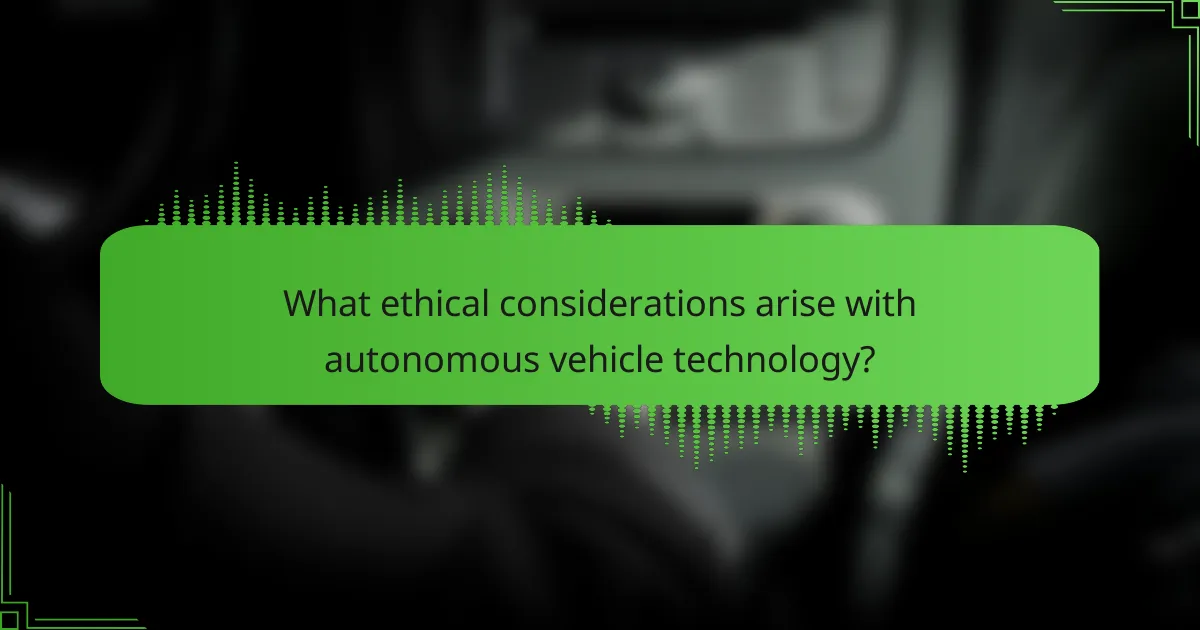
What ethical considerations arise with autonomous vehicle technology?
Ethical considerations for autonomous vehicle technology include safety, accountability, and privacy. Ensuring safety involves programming vehicles to make decisions that prioritize human life. Accountability raises questions about who is responsible for accidents involving autonomous vehicles. Privacy concerns relate to data collection from users, which could be misused. Addressing these issues is crucial for public acceptance and regulatory compliance.
How do we address liability in accidents involving autonomous vehicles?
Liability in accidents involving autonomous vehicles is primarily addressed through insurance policies and legal frameworks. As autonomous technology evolves, liability may shift from drivers to manufacturers or software developers. Current discussions focus on defining responsibility in multi-vehicle scenarios and accidents resulting from software malfunctions. This evolving landscape necessitates updated regulations to ensure accountability and consumer protection.
What are the implications for job displacement in driving professions?
Autonomous vehicles will likely lead to significant job displacement in driving professions. The shift to automation may eliminate millions of driving jobs, particularly in trucking and taxi services. Studies estimate that up to 3 million driving jobs in the U.S. could be at risk due to advancements in autonomous technology.
As a result, affected workers may face challenges in transitioning to new roles. Retraining programs will be essential to help displaced workers acquire skills for emerging industries. Policymakers must consider strategies to support workers during this transition, such as universal basic income or job creation in technology sectors.
The unique attribute of autonomous vehicles is their ability to operate without human intervention, which fundamentally changes the transportation landscape. The implications extend beyond job displacement, impacting urban planning, insurance, and safety regulations.
How should data privacy be managed in autonomous systems?
Data privacy in autonomous systems must prioritize user consent, data encryption, and secure data storage. Implementing robust privacy policies ensures compliance with regulations and builds user trust. Regular audits and transparency in data usage further enhance privacy management. Autonomous vehicles should limit data collection to essential information only, minimizing risks of data breaches.
What best practices can enhance the safe integration of autonomous vehicles?
Implementing best practices for the safe integration of autonomous vehicles involves a multi-faceted approach. Key strategies include establishing robust regulatory frameworks, investing in advanced sensor technologies, and promoting public awareness about autonomous systems.
1. Develop comprehensive regulations that address liability, safety standards, and data privacy.
2. Enhance sensor and AI technologies to improve vehicle perception and decision-making capabilities.
3. Conduct extensive testing in controlled environments before public deployment.
4. Foster collaboration between automakers, tech companies, and government agencies to share knowledge and resources.
5. Educate the public on the benefits and limitations of autonomous vehicles to build trust and acceptance.
6. Monitor and analyze real-world performance data to continuously improve systems and address emerging challenges.


